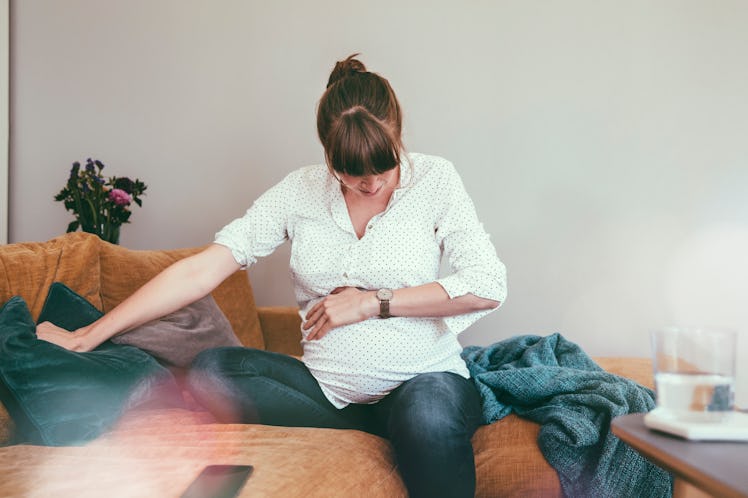10 Early Signs Of Labor That Tell You The Baby Is Near
Your very pregnant wife is going to give birth any moment now.

The early signs of labor are different for everyone. It would be great if there were hard and fast signs your body is getting ready for labor and how long you have to get to the hospital. But human beings, pregnancies, and symptoms before labor begins can vary significantly.
The following 10 signs of labor apply to a vast majority of childbirths, but they may not represent yours. It’s good to know the difference between back labor and contractions and whether your new nausea, diarrhea, or lack of appetite could be signs your body is getting ready for labor. But it’s always best to check with your doctor for advice.
1. Shivering
If it’s a sultry, hot summer day and your partner is piling on the layers like you’re headed for the ski lodge, it could be an indication of labor. “The change in body temperature is caused by labor hormones,” says Cheryl K. Baker, founder of Los Angeles Birth Partners, a certified childbirth educator and a doula who has delivered more than 1,000 babies.
2. No Appetite
Labor pains have a way of making the prospect of food less appealing. You can also expect that your wife may feel nauseous and thirsty as labor begins. You can help with both of these symptoms by offering her natural ginger chews to ease the stomach upset and a cup of ice chips to suck on as labor progresses.
3. A Feeling of Lightness
After nine months of carrying a bowling ball around in her stomach, your wife may feel the surprisingly pleasant sensation of lightness as childbirth draws near. This is actually the experience of the baby “dropping,” according to the American Pregnancy Association. This means that the baby has moved deeper down into the pelvis, relieving the pressure on the diaphragm that causes discomfort for so many pregnant people. On the other hand, the baby can now increase pressure on her bladder, meaning more nighttime trips to the bathroom in the final days.
4. Lower Back Pain
Although lower back pain could be a sign of many things, including the sheer act of lugging around extra weight all day, many people experience lower back pain and menstrual-like cramping in the early stages of labor. This in and of itself shouldn’t send you to the hospital, but it is a warning that the fun may be about to start.
5. Increasing Braxton-Hicks Contractions
Although Braxton-Hicks contractions are commonly thought of as a sign of false labor, these intermittent, fluttering, usually painless sensations become more frequent and noticeable in the early stages of labor. Note: This doesn’t mean your wife is about to deliver. Only that she’s getting closer. She could still be hours, or days, away.
6. Longer, More Regular Contractions
The clearest sign that labor is near comes from contractions that are getting progressively longer, more regular, and closer together. “You’re looking for surges that come four or five minutes apart, that last several minutes,” Baker says.
7. Stronger Labor Pain
One way to distinguish between true and false labor signs are contractions so strong that your wife cannot walk or talk through them. “Every labor is unique,” Baker says. “But in general, contractions get progressively more and more intense, requiring a woman’s complete attention as they happen.”
8. Bleeding and Mucus
This sounds dramatic, but actually, all it means is that the cervical plug has come loose, and there will be visible bleeding and mucus in your wife’s underwear. It’s normal. What’s not normal: “Any fluid that is brown or greenish in color could indicate that the baby is having a tough time,” Baker says. Another sign of labor in distress: Passing large blood clots. If this happens, see your doc right away.
9. Water Breaking
This classic, tell-tale sign of labor can appear as a big gush, or it can happen in a slow, light stream. Either way, the amniotic sac surrounding the baby has broken, and your kid is on the way. Normally, contractions begin before the water breaks. If that’s not the case, it’s important to head to the hospital anyway, since the “seal” around your baby is broken, raising the risk of infection.
10. Dilation
The classic countdown to the arrival of your new baby comes from dilation, a measurement of the cervix opening. This is as close as you’ll get to concrete real-time info on when childbirth is going to happen. But unfortunately, the only one who can accurately measure it is your doctor. Ten centimeters is considered fully dilated, signaling that your baby is on its way.
This article was originally published on